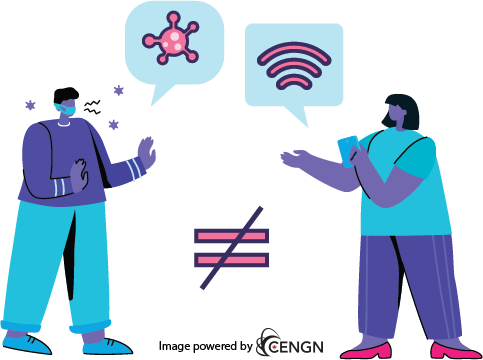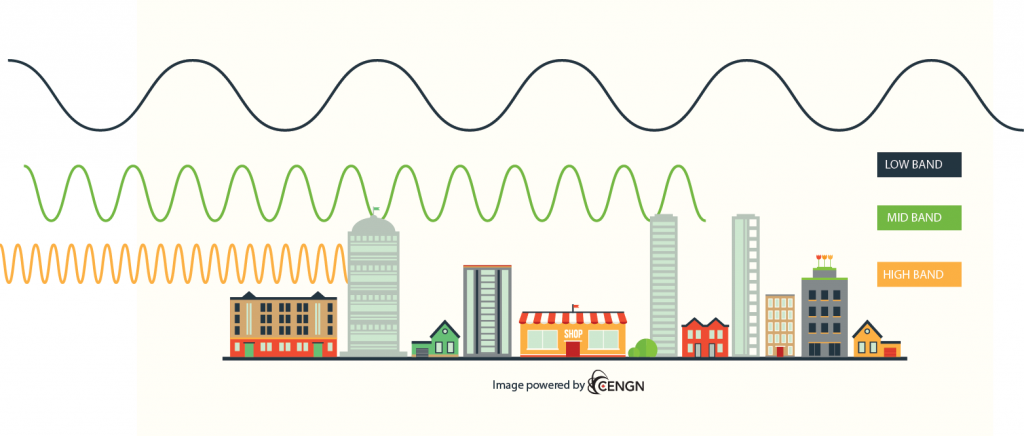More Innovation:
Why 5G is Safe: 5 Facts that Debunk 5G Conspiracy Theories
Updated: January 24, 2022
5G Conspiracy Theories
There’s been misinformation floating throughout the internet the past few months surrounding 5G conspiracies, seemingly a new one each day. With everyone claiming to be an “expert” these days, it’s hard to know what to believe and ignore.
Together, let’s set the record straight and answer the burning questions about the 5G conspiracies.
1. 5G is NOT Dangerous
To start, 5G is non-ionizing, meaning it isn’t harmful. 5G waves can’t penetrate living tissue, and therefore, aren’t dangerous. Although it is non-ionizing, we also have to understand that it operates at the same electromagnetic frequencies as a household microwave.
If that’s true, wouldn’t 5G be harmful?
The difference between 5G and microwaves is that a microwave works in an enclosed space. A microwave confines all its wattage into one small area with about 12.5 times more power than a 5G tower. This is why you can walk by a network of wireless towers safely but shouldn’t get inside a microwave.
The International Commission on Non‐Ionizing Radiation Protection (ICNIRP) is one of the independent bodies that govern and sets safe guidelines limiting exposure to electromagnetic fields, including 5G. The vice-chairman of ICNIRP, Eric van Rogen, made clear that “There’s no reason at all to believe that the immune system could be negatively influenced [by 5G].” (source: Global News)
So, this means that 5G can’t hurt us. And yes, this also means it cannot harm other living animals such as birds, as some seem to think. (source: The Guardian)
For more information about frequencies and false health concerns, check out our more in-depth look at the topic here: 5G in Canada: Is there a Health Concern?
2. 5G Did Not Cause COVID-19… and Radios Didn’t Cause the Spanish Flu

There’s been circulation of an unproven theory that there’s a relationship between the 5G conspiracy and the COVID-19 outbreak. This stemmed from a video presentation released earlier this year, claiming that the COVID-19 outbreak was directly caused by 5G towers being constructed within the area. The 5G conspiracy theorist behind the video is now on disciplinary probation from his practice and goes on to make another claim that radiation from the first radio towers caused the 1918 Spanish flu.
To make this very clear, these statements are false.
First of all, 5G is on an electromagnetic spectrum, while COVID-19 is a biological disease spread by a virus. One of Canada’s top virologists, Jason Kindracuk, backed this statement with scientific clarity. (Watch the video here). COVID-19 is proven to be caused by a virus, SARS-CoV-2. The conspiracy that 5G radiation poses an immune-suppressing health risk fails to consider that a virus is contracted through droplets, not radio waves.
On top of this, citywide 5G has been available in multiple places before it was introduced in China. While China did indeed launch 5G in 50 cities on Nov. 1, UK carrier EE launched it last May (2019). Sprint launched broad coverage 5G in nine US cities the previous summer (2019). If it had any COVID-19 relation, we would have had an outbreak much earlier. Looking from the other side, Iran, one of the countries hardest hit by COVID-19, had absolutely no 5G infrastructure. (source: Ericsson)
Lastly, let’s talk about the Spanish flu.
5G conspiracies also whole-heartedly believe that radio waves caused the 1918 flu. Yet, he fails to mention that the first commercial radio station was built in 1920, two years after the outbreak. As well, the Spanish flu only lasted 2 years, while radio continued to grow and become a staple for communication around the world. (source: RCI)
3. No, You’re Not Sensitive to 5G
Some people believe they have electromagnetic hypersensitivity (EHS) and are negatively affected by electromagnetic frequencies (EMF). The World Health Organization (WHO) clarifies that there is no scientific basis linking EMF to cause EHS symptoms (headaches, tiredness, nausea). Instead, there is an indication that these ordinary “EHS” symptoms are caused by pre-existing conditions. They can also be the result of people worrying so much about EMF’s possibilities that they convince themselves they are experiencing EHS, like the nocebo effect. (source: WHO)
As of August 2020, although 90% of US consumers are aware 5G networks exist, only 18% understand the difference in the types offered. By understanding what a next-generation network is and what it has to offer, you can better navigate the floods of misinformation surrounding the topic. (source: CI)
It’s essential to recognize that 5G operates on three different bands (high, medium, and low) within the electromagnetic spectrum, shared with other radio networks, including 4G, 3G, AM/FM radio, among others, which all operate at different frequencies. Each band offers additional strength to 5G. (source: T-Mobile)
So, what are the different 5G networks?

High-band millimetre-wave frequencies have high bandwidth available to carry high volumes of data in dense urban areas. The downside is it has a low coverage area and has limited penetration in buildings.
Mid-band is the median for speed and range, providing broad coverage and is less impacted by buildings. However, much of its bandwidth is already in use, so there’s not a lot available for 5G growth.
Low-band frequencies cover the most immense distance and can pass through more obstacles, providing a better, more reliable signal both indoors and out. The downside to low-band is the speeds are much slower and less reliable than mid and high-band.
Each band is being used in different companies depending on the population density and service area needed. In the 4 Canadian city deployments by Rogers, mid-band was used to offer a more reliable speed than low-band and a higher range than high-band. Alternatively, to provide a cross-country 5G service, T-Mobile uses low-band frequencies. (source: Verizon)
If EHS was a legitimate concern, the steady growth of networks would be correlated with an equal increase in these sensitivities reportedly linked to EMF, which it is not. More likely, EHS is a fabrication using non-specific symptoms to instill fear further popularized by 5G conspiracy theorists.
4. 5G is Just as Safe as 4G
The differences between 4G vs 5G are that 5G operates at a higher frequency and higher bandwidth, making it faster and more efficient. When someone hears higher frequency/bandwidth, their mind may jump straight to “higher risk,” which is false. Read more on the health impact of 5G here.
So, what exactly do frequency and bandwidth mean concerning a network?
Bandwidth defines the amount of data transmitted per second (bits/second). 4G bands accounted for between 5 MHz and 20 MHz of bandwidth per channel, where the 5G standard allows for between 5 MHz and 100 MHz of bandwidth per channel. This 5X increase in bandwidth correlates to roughly a 5X increase in data throughput, making 5G much faster. (source: Arrow)
On the other hand, frequency defines the number of complete data cycles per second (cycles/second). 4G LTE technologies used frequency bands around 600 MHz, 700 MHz, 1.7/2.1 GHz, 2.3 GHz, and 2.5 GHz. For 5G, the frequency band plans are much more complex, and waves expand up to 300GHz, although only 100GHz will be used for 5G deployments. The difference in frequencies between the two may seem significant for technical advancements. Still, in terms of health risk, they remain within the same non-ionizing (non-harmful) range.
To sum everything up, 5G is much more robust than 4G, but not more dangerous.
(One MHz is equal to one million cycles per second, one GHz equals one billion cycles per second. These are units of measurement for alternating current (AC) or radio wave frequencies.). (Learn more)
5. 5G is Our Friend
Networks have evolved over the years from 1G to 5G and have brought us enhanced connectivity and ease with every upgrade. With any change comes resistance, as society proves time and time again. But in the age of mass media, misinformation can spread rampantly, and it’s hard to spot. Researchers have independently established that parts of the current coronavirus 5G conspiracies are boosted by using bots, ingraining frightening false ideas into people’s minds. (source: Bloomberg)

People tend to focus on the negatives of change but overlook the direct benefits they’ll receive. So, what exactly can we expect from this next-generation network?
As we learned, 5G offers greater bandwidth than 4G. Greater bandwidth opens the door for more devices, which continue to enhance our lives in seemingly every way. From phones, watches, and even electrical outlets, everything seems to be “smart” these days, so we need the network to support it. These devices are making us more fit, keeping us connected and not to mention, 5G provides numerous benefits to our healthcare systems.
Think about the lag you get when using your device in a busy arena or a crowded classroom; this is a bandwidth issue from having too many devices in one area. 5G’s increased bandwidth allows for these IoT devices to operate on the same network, with 10 times reduced latency (lag) than 4G. (source: IoTs World Congress)
In terms of use cases, 5G will transform the way we utilize technology in every industry. For example, picture augmented reality in classrooms for emerged learning or having the capability to do massive data transfer across hospitals instantaneously when every second counts. This is not even mentioning ushering an era of automated sensor-based technology, enabling driverless cars that will reduce the number of collisions to zero, smart buildings and cities that are more environmentally friendly and cost-efficient, even sensors that will allow us to protect our wildlife and national parks by accurately predicting dangerous weather conditions before they happen.
All these things become possible because of 5G, enhancing our way of life, the strength of our communities and keeping us safe.
Combating the 5G Conspiracy Theories
The protests and destruction being fueled by 5G conspiracy theories must be combatted with facts highlighting the true nature and purpose of 5G. As technology continues to grow, the network needs to grow with it. This is why it is essential to understand that it is not a danger to us, but an ally. We need 5G networks to support continuous technological innovation and our connected way of living. (source: CBC)
Are you interested in hearing more about 5G and other innovative technologies?
Download our “Next Generation Network Imperative” Whitepaper to find out what the future of next-generation technologies looks like.
The International Data Corporation (IDC), a world-renowned global market intelligence firm, was commissioned to complete this study.









